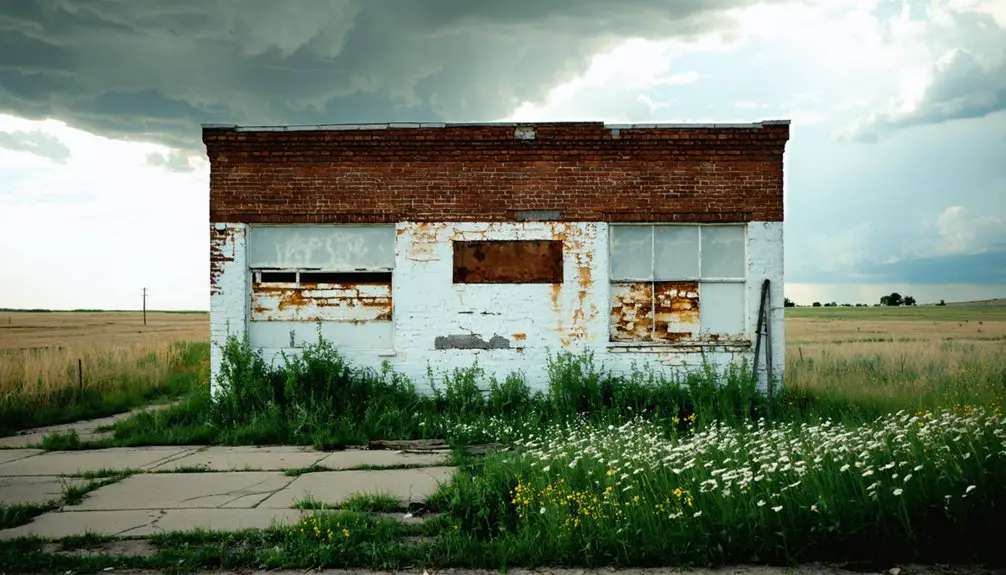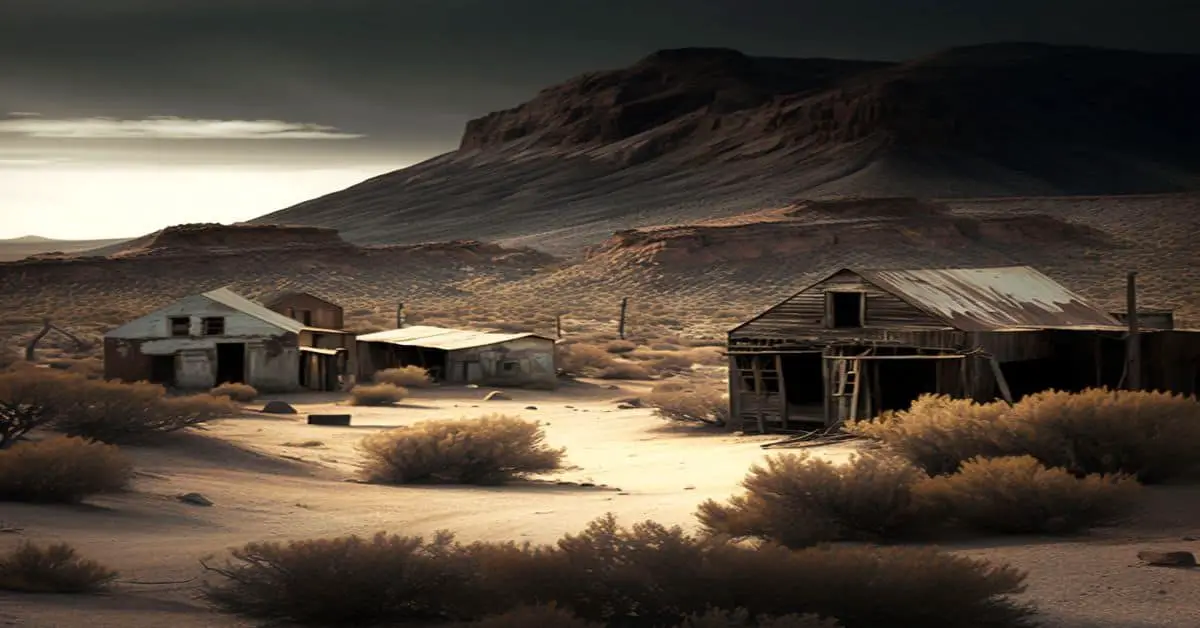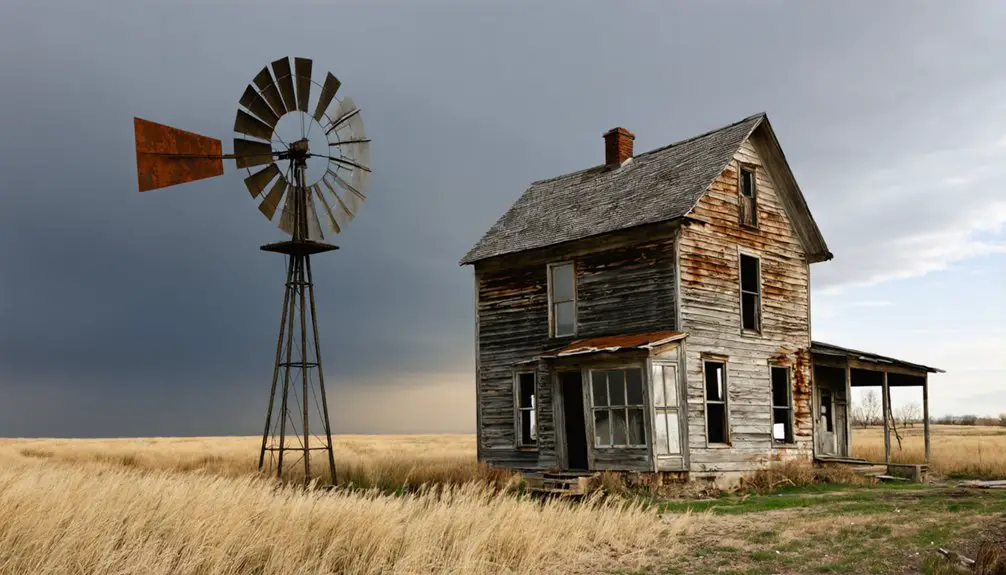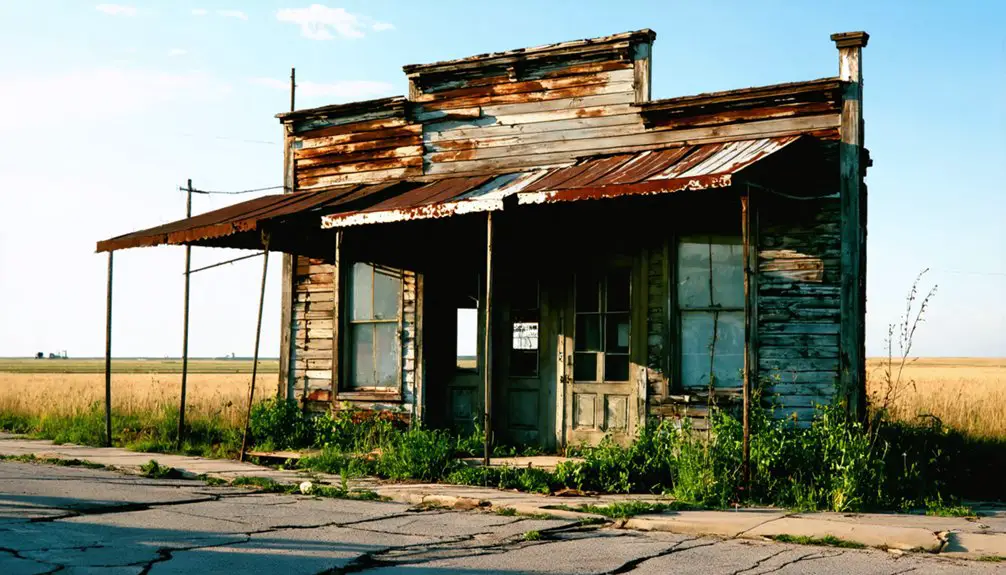You’ll find Monowi, Nebraska along a former railroad line that once bustled with 150 residents in the 1930s. Today, it’s America’s only incorporated municipality with a population of one – 89-year-old Elsie Eiler, who serves as mayor, tavern keeper, and librarian. She maintains the town’s incorporated status through careful paperwork while running the Monowi Tavern six days a week. Her story reveals how a determined spirit keeps a piece of American history alive.
Key Takeaways
- Monowi, Nebraska is not technically a ghost town, as it has one resident and maintains its incorporated status through its mayor.
- Founded in 1902 along the railroad, Monowi peaked at 150 residents in the 1930s before declining due to rural exodus.
- Elsie Eiler, the town’s sole resident, operates the still-functioning Monowi Tavern and serves as mayor, librarian, and business owner.
- The town features a self-serve library with 5,000 books and the Monowi Tavern, which attracts visitors from across the globe.
- Agricultural mechanization and youth migration to urban areas led to Monowi’s population decline, leaving only essential structures standing.
The Rise and Fall of a Railroad Town
As the Fremont, Elkhorn and Missouri Valley Railroad extended its tracks through northeast Nebraska in 1902, the town of Monowi emerged alongside it, taking its name from a Native American word for “flower.”
The strategic 208-mile branch line, later operated by Chicago & North Western Railroad, connected Norfolk, Nebraska to Winner, South Dakota, transforming Monowi into an essential agricultural hub.
During its heyday in the 1930s, you’d have found a thriving town of nearly 150 residents, complete with stores, restaurants, a church, and even a prison.
Today, the abandoned church stands silent, its empty pews now filled with old tractor tires.
The railroad history shaped Monowi’s destiny, with daily “Winner Motor” service connecting locals to regional commerce.
But post-WWII shifts saw town demographics plummet as youth sought urban opportunities.
Today, Elsie Eiler serves as the town’s sole resident and performs all municipal duties.
A Population of One: Meet Elsie Eiler
Today in Monowi, you’ll find just one determined resident keeping this historic railroad town alive: Elsie Eiler. At 89, she embodies resilience as she single-handedly manages every municipal role – from mayor to tavern keeper. The town experienced a dramatic decline from its peak of 150 residents in the 1930s.
Meet Elsie Eiler, Monowi’s sole citizen and unofficial superhero, wearing every municipal hat in America’s smallest town.
You’ll spot her at Rudy’s Tavern, where she works 12-hour days serving $2 beers and $3.50 burgers to curious visitors and local farmers. The tavern has welcomed guests from all fifty states and over 60 countries.
Monowi’s uniqueness as America’s smallest incorporated town rests on Elsie’s shoulders. She maintains the town’s infrastructure by collecting taxes from herself, creating annual road plans, and granting her own liquor license.
When she’s not running the tavern, she oversees the Rudy Eiler Memorial Library, named after her late husband, preserving hundreds of books for visitors to enjoy.
Daily Life as Mayor, Bartender, and Everything Else
Five distinct municipal roles converge in Elsie’s daily routine as she manages Monowi’s essential operations.
You’ll find her engaged in remarkable municipal multitasking, from maintaining the town’s four streetlights to filing critical road maintenance plans for state funding. As mayor, she oversees the village’s infrastructure while simultaneously serving as treasurer, clerk, and librarian.
Her unique governance style involves issuing herself a liquor license for the tavern, collecting taxes from herself, and managing all official documentation. She operates the Monowi Tavern daily, staying open six days a week to serve visitors and maintain social connections.
The tavern has been a central gathering spot since her husband’s passing in 2004, when she became the sole resident of the village.
She’s created a sustainable economic model through tourism revenue, tavern sales, and state road funds.
Every day, she balances essential civic duties without support staff, demonstrating how a one-person administration can maintain a legally incorporated village through focused dedication and strategic adaptation.
The Beating Heart: Monowi Tavern
At the heart of Monowi lies the iconic Monowi Tavern, where you’ll find legendary ribeye steaks and cold beer served in vintage Budweiser mugs amid Nebraska Cornhuskers memorabilia.
You’ll experience an authentic slice of rural Americana as you sign the guestbook that’s captured signatures from worldwide visitors since 1971, when Rudy and Elsie Eiler first opened the tavern’s doors.
The establishment serves as more than just a bar – it’s a living museum of railroad-era history and the last remaining business in town, keeping Monowi’s spirit alive through food, fellowship, and preservation of local culture. The tavern has welcomed guests from all 50 states and dozens of countries over its five decades of operation. Open daily except Mondays, the tavern continues to draw both locals and curious travelers to this remarkable one-person town.
Food and Local Culture
Located in the heart of America’s smallest incorporated town, Monowi Tavern serves as both a culinary destination and cultural touchstone under the sole proprietorship of Elsie Eiler. The establishment embodies authentic rural hospitality while preserving local culinary traditions through its renowned menu and warm atmosphere. Visitors can engage in friendly conversations with Elsie while enjoying their meals. The tavern has maintained its charming presence for over 50 years in this remote Nebraska location.
- You’ll find signature dishes including “Nebraska’s best ribeye,” handcrafted burgers, and crispy onion rings, all prepared fresh daily.
- The tavern’s walls showcase Nebraska Cornhuskers memorabilia and vintage Budweiser mugs, creating a living museum of local history.
- Your dining experience includes ice-cold beer paired with hearty portions at reasonable prices.
- You’re encouraged to sign the guestbook, joining visitors from around the world who’ve experienced this authentic slice of Americana.
The tavern remains a tribute to enduring small-town values, drawing travelers seeking genuine American roadside experiences.
Small Town Social Hub
Beyond its culinary offerings, Monowi Tavern stands as the social nucleus of America’s smallest incorporated town. Since 1971, when Elsie and Rudy Eiler first opened its doors, the tavern has served as the village’s only public gathering space, drawing visitors from across the globe who seek authentic Americana.
You’ll find the walls adorned with Nebraska Cornhuskers memorabilia and vintage beer mugs, creating an atmosphere rich in local nostalgia.
As proprietor and town mayor, Elsie maintains the tavern as a living museum where community storytelling flourishes. She shares tales of Monowi’s railroad past, its agricultural heritage, and the town’s peak years when 150 residents called it home.
The tavern’s guestbook, filled with signatures from worldwide travelers, testifies to its enduring draw as a symbol of rural resilience.
Literary Legacy: Rudy’s 5,000-Book Library
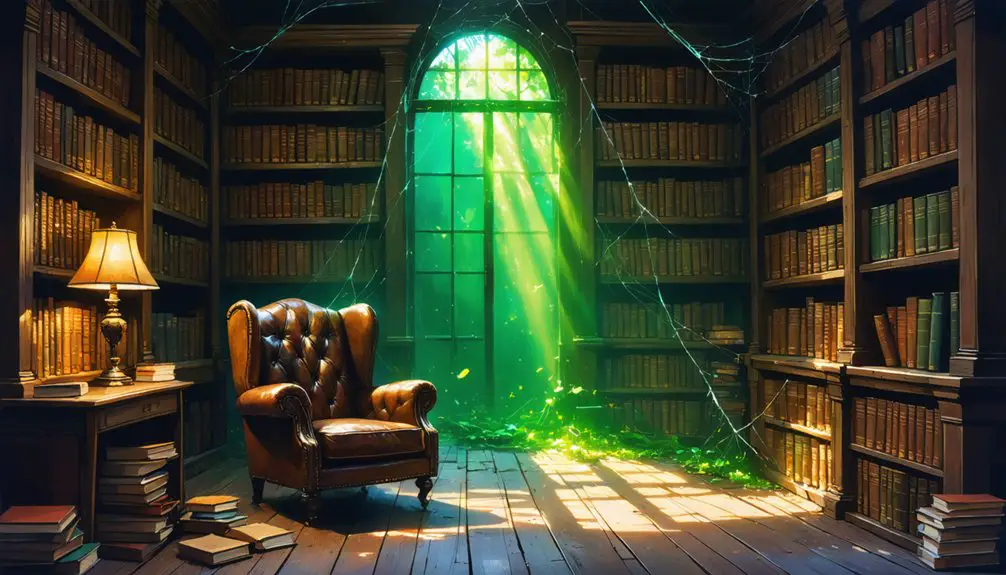
One of Monowi’s most cherished landmarks, Rudy’s Library, emerged in 2005 when Elsie Eiler established a 320-square-foot shed to house her late husband’s collection of 5,000 books.
Nestled in tiny Monowi, Rudy’s Library showcases 5,000 books in a modest shed, preserving one man’s literary legacy since 2005.
This self-serve lending library stands as a tribute to literary preservation and community engagement in America’s smallest incorporated town.
- You’ll find worn books, magazines, and newspapers dating back to the 1940s, reflecting Rudy’s diverse reading interests.
- The library operates on an honor system where you sign a notebook to borrow materials.
- A wooden sign inside reads “Rudy’s Dream,” marking this space as both memorial and cultural hub.
- You can explore the collection alongside visiting the Monowi Tavern, making it part of the town’s unique tourist experience.
Rural Exodus and Great Plains Depopulation
If you’d visited Monowi during its 1930 peak of 150 residents, you’d have seen a thriving community that reflected the Great Plains’ early 20th century agricultural prosperity.
Like thousands of similar small towns across Nebraska and neighboring states, Monowi’s population steadily declined as farming became increasingly mechanized and younger generations sought better economic opportunities in urban areas.
Generational Migration Patterns
Since the mid-20th century, the Great Plains has experienced a dramatic generational exodus that’s reshaped its demographic landscape.
You’ll find stark generational shifts particularly among young adults aged 20-24, who’ve consistently left rural counties at staggering rates. These population trends have created a self-reinforcing cycle of decline across the region.
- Young adults flee at a rate of 43% per decade in depopulating counties
- Counties reliant on agriculture (>38% employment) face persistent population losses
- Aging populations push median ages above 35 in declining areas, while growing regions maintain ages under 29
- Birth rates plummet as women of childbearing age depart, while death rates climb with aging residents who remain
This migration pattern has transformed once-vibrant farming communities into increasingly elderly populations with diminishing economic prospects.
Economic Opportunities Fade Away
Throughout the Great Plains, traditional agricultural economies have fundamentally transformed, leaving rural communities with diminishing prospects for sustainable employment.
You’ll find farms growing larger but employing fewer workers, while small family operations struggle to remain viable. These economic challenges ripple through entire communities as local businesses, schools, and services shut down.
What you’re witnessing isn’t just about farming – it’s a complex web of decline. As young people move away seeking better opportunities, they take with them the entrepreneurial spirit and workforce skills that once sustained community resilience.
The tax base shrinks, making it harder to maintain essential infrastructure. While some areas find temporary booms through oil extraction, most rural counties have lost over 60% of their peak populations, creating a cycle of economic contraction that’s increasingly difficult to reverse.
Preserving a Town’s Spirit Against All Odds
Despite the immense challenges of maintaining a one-person town, Monowi’s spirit endures through the determined efforts of its sole resident, Elsie Eiler. Her unwavering commitment to preserving rural identity and fostering community resilience has transformed this tiny Nebraska settlement into a symbol of American perseverance.
- You’ll find Elsie managing multiple roles, from mayor to librarian, ensuring Monowi maintains its incorporated status through meticulous paperwork and annual state requirements.
- The town’s cultural heritage lives on through Rudy’s Library, housing over 5,000 books, and the historic Monowi Tavern.
- Visitors can experience authentic rural Americana through Elsie’s storytelling and hospitality.
- Every maintained building and preserved artifact stands as testimony to one person’s dedication to keeping their hometown’s legacy alive.
Frequently Asked Questions
How Does Elsie Handle Medical Emergencies in Such an Isolated Location?
You’ll need to rely on external medical resources, following emergency protocols to contact regional transport services and coordinate with distant hospitals for urgent care when isolated.
What Happens to Monowi’s Incorporation Status After Elsie Passes Away?
Like a flame without fuel, your town’s incorporation will likely extinguish when there’s no one left. Without future governance, you’ll see the municipality dissolve and revert to unincorporated county land.
How Does the Town Generate Revenue to Maintain Its Basic Infrastructure?
You’ll find revenue comes from the tavern’s daily operations, tourist attractions drawing curious visitors, state road funding for Highway 12, and streamlined municipal management that keeps costs low for the local economy.
What Are the Nearest Neighboring Towns and How Far Away?
You’ll find Lynch about 7 miles northeast as your closest neighbor, with Gross under 10 miles away. Verdel and Bristow are within 15 miles, while South Dakota’s Ree sits roughly 10-15 miles north.
Does Elsie Ever Take Vacations, and Who Manages the Town Then?
She’s tied to the hip with her responsibilities, so you won’t find Elsie taking vacation plans. Since she’s the only resident handling town management, there’s nobody else to run things.
References
- https://thesmartrver.com/monowi-nebraska/
- https://www.thetravel.com/smallest-town-in-america/
- https://thetravelbible.com/monowi-nebraska-the-town-with-a-population-of-one/
- http://www.hervoiceonline.com/news/throughthelens972.html
- https://faroutmagazine.co.uk/monowi-nebraska-one-woman-town-literally/
- https://www.trains.com/trn/news-reviews/news-wire/12-nebraska-town-with-one-resident-has-a-railroading-past/
- https://exploringabandonedhistorybyjake.blogspot.com/2018/01/urban-exploring-trip-6-part-2-monowi.html
- https://guinnessworldrecords.com/news/2025/5/inside-the-town-with-lowest-population-where-one-woman-is-mayor-librarian-and-bartender
- https://www.undiscoveredamerica.tv/a-one-woman-town-with-a-big-story-visiting-monowi-nebraska
- https://en.wikipedia.org/wiki/Monowi
